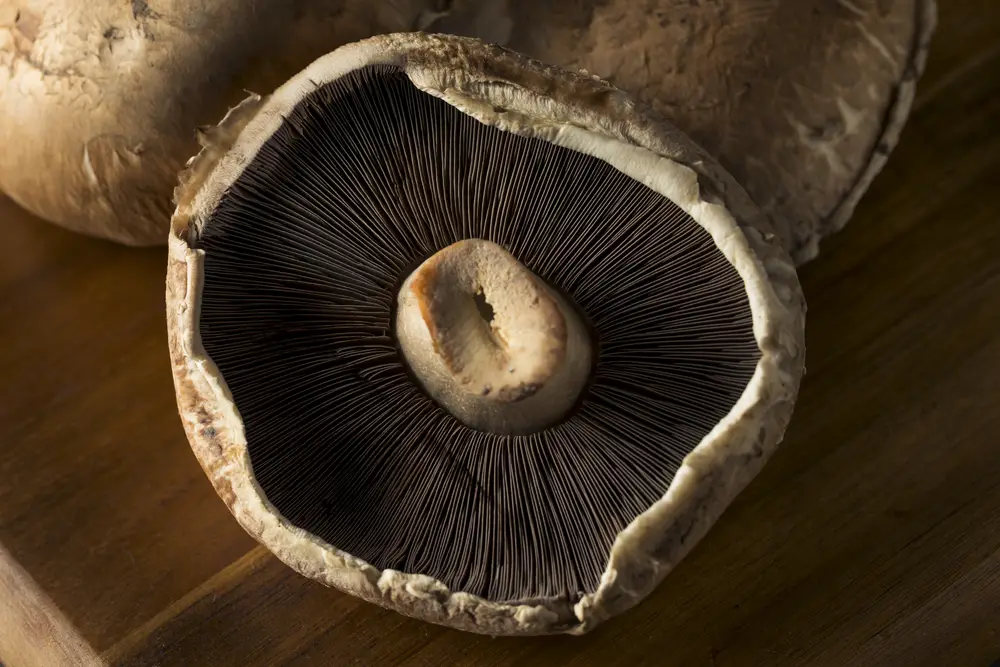Portobello mushrooms are a popular and widely enjoyed edible mushroom variety, often praised for their rich taste and versatility in cooking. However, there are some potential negative effects associated with their consumption that have raised concerns among health-conscious individuals.
While they are generally considered safe to eat, it is important to be aware of these potential risks to fully enjoy the benefits of incorporating portobello mushrooms into one’s diet.
Some individuals may experience allergic reactions to portobello mushrooms, ranging from mild symptoms like itching or hives to more severe reactions such as difficulty breathing. In addition to allergies, portobello mushrooms contain substances known as FODMAPs, which can lead to digestive issues, particularly in individuals with sensitive digestive systems or irritable bowel syndrome (IBS).
Consuming these mushrooms may cause bloating, gas, abdominal pain, or diarrhoea due to their high fibre content and presence of FODMAPs.
Moreover, there have been discussions regarding the possibility of portobello mushrooms being carcinogenic. Although this topic remains contentious and requires further research, it highlights the need for consumers to be cautious and informed when adding portobello mushrooms to their meals.
Understanding Portobello Mushrooms
Portobello mushrooms, also known as Agaricus bisporus, are a popular and widely cultivated edible mushroom species. Originating from the grasslands of Eurasia and North America, they are known for their large size, hearty texture, and distinct umami flavour. This species of mushroom is also referred to as portabella, portabello, cremini, crimini, common white mushroom, white button, or baby bella.
These mushrooms come in different colours and forms, which are all derived from the same species, Agaricus bisporus. The most common forms are white button mushrooms and brown mushrooms. Portobello mushrooms are simply the mature, larger version of these brown mushrooms.
Despite their culinary popularity, there have been concerns regarding the potential negative effects of portobello mushrooms. Some individuals may experience allergic reactions to this mushroom, ranging from mild symptoms like itching or hives, to more severe reactions such as difficulty breathing1. It is essential for those with known mushroom allergies to exercise caution when consuming portobello mushrooms.
In addition to this, portobello mushrooms contain substances known as FODMAPs, which can cause digestive issues for individuals with sensitive digestive systems or irritable bowel syndrome (IBS). It is recommended for those experiencing gastrointestinal issues to consult with their healthcare professional before regularly consuming portobello mushrooms.
While some potential negative effects have been identified, portobello mushrooms also offer numerous health benefits. They are high in vitamins, minerals, and dietary fibre, making them a nutritious addition to a balanced diet. As with any food, moderation and a varied diet are key to enjoying the benefits of portobello mushrooms while minimising any potential risks.
Cooking and Eating Portobello Mushrooms
Portobello mushrooms are a versatile ingredient that can be used in various dishes due to their rich, earthy flavour and meaty texture. To enjoy their full potential, it is essential to prepare and cook them correctly.
When cooking portobello mushrooms, it is important to ensure they are cooked at the right temperature. In general, a medium to high heat is recommended for proper cooking. Cooking at this temperature helps to break down the hydrazine toxin found in mushrooms, making them safer to consume.
There are numerous cooking techniques and dishes where portobello mushrooms can shine. One popular option is sautéing the mushrooms in a pan with a little oil or butter until they become tender and golden. Sautéed mushrooms work beautifully as a side dish or can be added to pasta or risotto for extra flavor.
Another delicious way to enjoy portobello mushrooms is as a pizza topping. Simply slice the mushrooms and add them to your pizza before baking. The mushrooms will absorb the flavours from the other ingredients while providing a delightful, meaty texture. Remember to cook the pizza at a high temperature to ensure the mushrooms are cooked sufficiently.
Besides sautéing and using as pizza toppings, portobello mushrooms can also be stuffed, grilled, or roasted. When grilling or roasting, it is advisable to marinate the mushrooms beforehand to prevent them from drying out and to enhance their flavour. Common marinade ingredients include garlic, herbs, and balsamic vinegar.
Regardless of the cooking method chosen, always clean the mushrooms properly before cooking and make sure they are cooked thoroughly. This ensures a delicious and safe eating experience.
General Negative Effects of Mushrooms
Portobello mushrooms, like other mushroom varieties, can have some negative effects on certain individuals. One of the main concerns is the presence of a toxin called hydrazine, which is also used in rocket fuel. This toxin is especially prevalent in portobello and shiitake mushrooms.
Another harmful substance found in portobello mushrooms is agaritine. A study published by the National Library of Medicine discovered evidence of agaritine in fresh mushrooms, and when fed to mice, it led to increased rates of bladder cancer. However, it should be noted that the levels of agaritine in mushrooms consumed by humans are significantly lower.
In some cases, consuming portobello mushrooms can cause digestive discomfort such as bloating, gas, abdominal pain, or diarrhoea. This is primarily due to the mushroom’s high fibre content and certain compounds called FODMAPs. Individuals with sensitive digestive systems or irritable bowel syndrome (IBS) may be more susceptible to these adverse effects.
Additionally, some people may experience allergic reactions to portobello mushrooms, ranging from mild symptoms like itching or hives to severe reactions such as difficulty breathing. If you suspect an allergy to portobello mushrooms, it is crucial to seek medical attention immediately.
It is essential to be aware of the potential negative effects of portobello mushrooms and take any necessary precautions when consuming them. Cooking methods such as sautéing, grilling, or baking can help eliminate some toxins and reduce the risk of adverse effects. However, if you have concerns or experience any of the symptoms mentioned above, it is best to consult with a healthcare professional before including portobello mushrooms in your diet.
Health Risks Associated with Portobello Mushrooms
Portobello mushrooms, like other mushrooms, can potentially be contaminated with heavy metals, bacteria, and various toxins if they are grown in a polluted environment. It is essential to source mushrooms from reputable suppliers to minimize the risk of consuming contaminated mushrooms. Eating raw mushrooms may increase the chances of ingesting harmful bacteria and fungi, which can cause digestive issues such as bloating, gas, and diarrhoea.
Some compounds found in portobello mushrooms have been linked to potential health issues. One of these compounds is agaritine, a naturally occurring substance in some mushrooms, including portobellos. Studies suggest that agaritine may be carcinogenic in high doses, which could potentially increase the risk of cancer.
Portobellos also contain hydrazines, chemical compounds that have been associated with negative side effects like nausea and difficulty breathing. However, it is important to note that most studies on these compounds have been conducted on animals or in vitro, and their effects on humans are not fully understood.
Portobello mushrooms are also rich in purines, molecules that can be broken down into uric acid in the body. High levels of uric acid may lead to kidney stones or gout, a painful form of arthritis. Those with a history of gout or kidney stones should limit their consumption of purine-rich foods, including portobello mushrooms.
In rare cases, some individuals may experience allergic reactions to portobello mushrooms or other members of the Agaricus bisporus family. Symptoms of an allergic reaction include itching, difficulty breathing, and in severe cases, anaphylaxis, a potentially life-threatening reaction. Anyone who suspects they may be allergic to portobello mushrooms should consult a healthcare professional and avoid consuming these mushrooms.
While portobello mushrooms are generally safe for consumption when cooked and sourced from reputable suppliers, it is essential to be aware of the potential risks associated with them. Varying one’s diet and incorporating a wide range of vegetables and other types of mushrooms can help minimize the potential health risks associated with consuming portobello mushrooms.
Allergies and Reactions to Portobello Mushrooms
Allergies and reactions to portobello mushrooms are not uncommon and can manifest in various ways. Individuals who have a known allergy to mushrooms in general may be more likely to experience issues when consuming portobellos.
One common allergic reaction to portobello mushrooms is the occurrence of skin rashes, including hives. These can be itchy and uncomfortable, and may be an indication of a more severe reaction taking place. Additionally, some people might experience gastrointestinal disturbances, such as diarrhoea, as a result of consuming these mushrooms. This can be due to either an allergy or contamination of the mushrooms.
Contamination can occur if the mushrooms have been exposed to toxins or harmful substances during the growing process or preparation. It is essential to properly clean and cook portobello mushrooms to minimise the risk of contamination and potential health issues.
If an individual experiences difficulty breathing or swelling of the face, lips, or tongue after consuming portobello mushrooms, it is important to seek medical attention immediately. These symptoms may indicate a severe allergic reaction that requires treatment by a healthcare professional.
To avoid adverse reactions to portobello mushrooms, it is important to be aware of any known allergies or sensitivities. When consuming these mushrooms for the first time, it is wise to start with a small portion to assess any potential reactions. Additionally, always ensure the mushrooms are properly cleaned, prepared, and cooked to minimise the risk of contamination.
Nutritional Facts of Portobello Mushrooms
Portobello mushrooms, also known as Agaricus bisporus, are a popular choice for vegetarian dishes due to their meaty texture and rich flavour. This type of mushroom not only serves as a delicious ingredient but also provides an array of essential nutrients, making it a healthy addition to any meal.
A 100 gram serving of portobello mushrooms contains approximately 26 calories, with a low carbohydrate content of about 4 grams, and a small amount of fat and protein. These nutritional values make it an ideal choice for individuals looking for a low-calorie, nutrient-dense food option.
The mushroom’s rich nutrient profile includes a variety of vitamins and minerals. It is a good source of B vitamins, such as niacin, riboflavin, and pantothenic acid, which help support energy metabolism and maintain the nervous system. Portobello mushrooms also provide a modest amount of antioxidants, promoting healthy cellular functions and overall well-being.
In terms of minerals, portobello mushrooms are a notable source of potassium, which is vital for maintaining fluid balance and regulating blood pressure. They also provide substantial levels of phosphorus and selenium, which contribute to bone health and support the immune system. Additionally, the presence of iron in this mushroom aids in oxygen transport and helps prevent anaemia.
The high fibre content in portobello mushrooms aids in digestion and can also assist in promoting healthy weight management. Regular consumption may alleviate digestive discomfort, such as bloating and gas, while fostering a sense of fullness and potentially reducing overall calorie intake.
In conclusion, including portobello mushrooms in your diet can provide a multitude of nutritional benefits. Their low calorie content and high nutrient density make them a valuable addition to any healthy eating plan, particularly for vegetarians seeking to incorporate more plant-based sources of essential vitamins and minerals.
Safety Measures and Recommendations
When consuming portobello mushrooms, it is essential to take some safety measures to ensure they are safe to eat and provide maximum health benefits. One crucial aspect of food safety, particularly with mushrooms, is to ensure they are free from contamination during cultivation, harvest, or storage. It is recommended that consumers thoroughly wash, handle, and store mushrooms correctly to avoid any potential risks.
A balanced diet is crucial for maintaining optimum health. Integrating portobello mushrooms into one’s diet should be done in moderation, as excessive consumption may lead to digestive issues. Additionally, some studies have found that the presence of agaritine in mushrooms can potentially increase the risk of cancer, making mindful consumption all the more important.
It is advisable to gain knowledge about the potential negative side effects of portobello mushrooms and be aware of the signs and symptoms of an adverse reaction. If an individual experiences any discomfort after consuming portobello mushrooms, they should seek medical attention promptly, particularly in the case of an allergic reaction.
Consulting healthcare professionals for personalised advice can further ensure portobello mushrooms are consumed safely and can be a beneficial part of a balanced diet.
Important Persons and Research on Portobello Mushrooms
Paul Stamets, a world-renowned mycologist, has expressed concerns regarding the consumption of portobello mushrooms. During an interview on Joe Rogan’s podcast, Stamets touched upon the potential negative effects of portobellos and raised awareness among listeners. However, it’s essential to understand that his view is not universally shared, and scientific research on the subject is ongoing.
Among the research on portobello mushrooms, one notable publication is the Journal of Functional Foods. The journal has published several studies exploring the nutritional and health effects of various types of mushrooms, including the portobello. These studies often take a deeper look at the compounds within the mushroom and their potential impact on human health.
It is worth noting that portobello mushrooms are widely cultivated and consumed in many countries. They are appreciated for their umami flavour and rich texture, which makes them a popular choice among vegetarians and vegans seeking a meat substitute. Portobellos have also been found to contain essential nutrients, such as vitamins and minerals, that contribute to a well-balanced diet.
In conclusion, it is evident that Paul Stamets’ perspective on portobello mushrooms has drawn attention to the potential negative effects associated with their consumption. However, research within the Journal of Functional Foods and other scientific publications continues to offer valuable insights into the health benefits and risks of these mushrooms.
As a result, it is essential for individuals to consider their own dietary needs and sensitivities when deciding whether to include portobello mushrooms in their diet.
Comparison with Other Mushroom Varieties
Portobello mushrooms, also known as portabella or portabello mushrooms, are loved for their rich taste and meaty texture. They belong to the same species as white button and cremini mushrooms, Agaricus bisporus. However, there are some notable differences, as well as potential negative effects, when comparing portobello mushrooms with other mushroom varieties.
Portobello mushrooms are more mature than white button and cremini mushrooms. This maturity affects their appearance, taste, and texture. White button mushrooms are the youngest variety, with small, round caps and a mild flavour. Cremini mushrooms, sometimes referred to as brown mushrooms, are mid-aged and have a slightly darker cap and a more robust flavour. Portobellos are the most mature of the three, evidenced by their large size and broad, flat caps. They have a rich, earthy taste and a dense, meaty texture.
Mushroom lovers often consider wild mushrooms to have superior flavour and culinary characteristics compared to cultivated varieties. Wild mushrooms come in a range of shapes, sizes, and colours, including edible strains such as chanterelles, morels, and porcinis. These wild varieties tend to be more expensive and less readily available than portobellos, but they can offer a more unique and exotic taste experience for food enthusiasts.
In terms of nutritional value, portobellos, button mushrooms, and cremini mushrooms share similar nutrient profiles, providing a good source of vitamins, minerals, and dietary fibre. However, one concern raised about portobello mushrooms specifically is their potential to produce small amounts of hydrazine, a chemical used in rocket fuels, and agaritine, which is considered carcinogenic in high doses Paul Stamets on Joe Rogan’s podcast.
While the levels of these compounds in portobello mushrooms are generally considered low and not harmful when consumed occasionally, excessive consumption could be a cause for concern.
When comparing the potential negative effects, it’s essential to be mindful of individual reactions to different mushroom varieties. Some individuals may experience digestive discomfort, such as bloating, gas, or abdominal pain, after consuming portobello mushrooms due to the fibre content. Such reactions could also occur with the consumption of button, cremini, or wild mushrooms. It is important to pay attention to personal responses and adjust one’s diet accordingly.
In summary, portobello mushrooms offer a distinct flavour and texture compared to other mushroom varieties, but they share many similarities with their more youthful relatives, such as button and cremini mushrooms. Wild mushrooms present an additional range of tastes and textures to explore. As with any food, moderation and an understanding of one’s unique reactions to specific varieties are vital for making informed dietary choices.
Portobello Mushrooms in Different Regions
Portobello mushrooms, also known as Agaricus bisporus, are widely cultivated edible mushrooms originating from Eurasia and North America grasslands. They are commonly used in various cuisines due to their rich flavour and texture. This section focuses on the regional variations, specifically in Pennsylvania, and any potential negative effects of Portobello mushrooms.
In Pennsylvania, Portobello mushrooms are cultivated in the southeastern part of the state, with Chester County being a major production area. This region is well-suited for mushroom farming due to its favourable climate and rich, fertile soil. The mushrooms are grown in controlled environments, ensuring consistent quality and reducing exposure to harmful elements.
Nonetheless, it is crucial to remain aware of potential negative effects associated with Portobello mushrooms. One cause for concern is a group of compounds known as agaritines. If not properly cooked, these hydrazines can be harmful, as some of them have the potential to be both beneficial and detrimental. Proper cooking methods can mitigate these issues, but it is essential for consumers to be well-informed about potential risks.
Regarding regional impact, it is uncertain whether Pennsylvania-grown Portobello mushrooms differ significantly from those cultivated in other locations. Factors such as local environmental conditions, cultivation methods, and storage practices may all influence the properties and potential risks associated with these mushrooms. Further research and monitoring are necessary to ensure the safety and quality of Portobello mushrooms grown in Pennsylvania and other regions.
As a concluding remark, it is essential for consumers to educate themselves about the potential negative effects of Portobello mushrooms and apply proper cooking techniques to minimise health risks. Continued cultivation and research in Pennsylvania and other regions can contribute to a better understanding of this popular edible mushroom and promote safe consumption practices.
My name is Ellis Francis and I have been a personal fitness trainer, sports nutritionalist and health and fitness advisor for over 25 years. I am the lead health and fitness advisor at https://awellnessbody.com.








